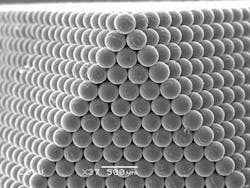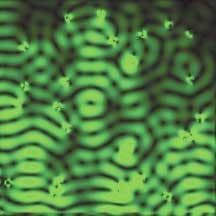Newsbreaks
Tunable femtosecond pulses in the blue are generated in BIBO
Combining the advantages of UV transparency and the high damage threshold of beta barium borate (BBO) and lithium triborate crystals with the enhanced linearity of potassium titanyl phosphate crystals, bismuth borate (BIBO) is showing promise as an improved material for nonlinear frequency-conversion applications. Researchers from the Institut de Ciences Fotoniques (Barcelona, Spain), the Institute of Applied Physics at the Military University of Technology (Warsaw, Poland), and the Technical University of Czestochowa (Czestochowa, Poland) have reported efficient single-pass second-harmonic generation (SHG) of tunable femtosecond pulses into the blue by use of BIBO, with demonstrated average powers of 830 mW at conversion efficiencies just over 50%.
A modelocked Ti:sapphire laser delivered pulses of 130 fs at a 76-MHz repetition rate with an average power of 1.9 W over a range from 750 to 950 nm into several BIBO crystals from 0.4 to 1.4 mm in length. Wavelength tuning was achieved from 375 to 435 nm, with the highest SHG output power and efficiency being observed in the longest crystal. Direct comparison of a 0.5-mm BBO crystal with a 0.4-mm BIBO crystal showed a 34% power enhancement when using BIBO, despite its shorter crystal length. Contact Masood Ghotbi at [email protected].
Fiber sensor exploits self-pulsing to detect hydrogen
Though fiberoptic sensors based on the intracavity-absorption loss of erbium-doped fiber lasers have been developed for hydrogen detection, self-pulsing behavior leads to errors in measured power values. A team of researchers from the Universidad de Valencia (Burjasot, Spain) has developed a similar technique that instead exploits this self-pulsing behavior of the laser transient observed when the pump is switched on, instead of relying on the changes in laser-power emission.
The buildup time of a pump laser-the time delay between the pump being switched on and the appearance of the first pulse-depends on the active-medium properties, the pump-power level, and the cavity losses. By placing a palladium-coated tapered fiber inside an erbium-doped fiber-laser cavity, a decrease in attenuation is observed when this sensing element is exposed to hydrogen. The attenuation decrease translates to a cavity loss, which in turn modifies the buildup time and directly correlates to the measurement of hydrogen concentration in the time domain. Relative variations in the buildup time of up to 55% with an increase in hydrogen concentration from 0% to 10% were achieved with a resolution better than 0.1%. Contact Arturo Ortigosa Blanch at [email protected].
Etched spheres are basis of terahertz photonic crystal
Researchers from Tohoku University (Sendai, Japan) have fabricated a 3-D inverse photonic crystal with transmittance in the terahertz wavelength region. Terahertz waves are finding numerous applications in biological tissue imaging and explosives detection, but development of materials to control and confine the waves has been difficult because of their submillimeter periodicity, which does not lend itself to mechanical or semiconductor techniques successful in development of 3-D photonic crystals for millimeter waves and IR to visible light.
To create a photonic structure with a terahertz periodicity, the researchers fabricated copper spheres with an approximate diameter of 300 μm by a pulsated-orifice-ejection method. The spheres were packed and vibrated into a 3-D template that was then filled with a dielectric medium under vacuum. After curing the dielectric and etching away the copper spheres, an inverse photonic crystal was formed with a dielectric constant of 2.72. Theoretical prediction of the photonic-band structure by the plane-wave-expansion method yielded a photonic bandgap of 0.55 to 0.62 THz, which agreed well with the 0.48- to 0.64-THz value recorded by an actual transmittance-spectrum measurement. Contact Kenta Takagi at [email protected].
Ultrafast laser approaches intensity of 1022 W/cm2
Focused pulsed laser beams that achieve ultrahigh intensities help explore the physics of how light interacts with matter. The maximum intensity achieved by a laser has hovered at around 1021 W/cm2 for a couple of years; now, researchers at the University of Michigan (Ann Arbor, MI) using adaptive optics have generated a peak laser intensity of 0.7 × 1022 W/cm2. They also show how an incremental improvement will boost intensity even higher.
An all-Ti:sapphire laser and amplifier combination produces pulses that, after compression, are 1.4 J and 30 fs, reaching a 45-TW peak intensity. An f/0.6 off-axis paraboloid paired with a deformable mirror focuses the beam. The researchers measure phase and amplitude of the focal spot with a Shack-Hartmann wavefront sensor and do calculations to determine spot size and focal-field details. Correction of differential phase at high energy (aberrations from power amplifiers) should boost intensity to 1 × 1022 W/cm2. Such a scheme is possible because the laser has high shot-to-shot wavefront stability. The team hopes to further upgrade the system to reach an intensity of 1 × 1023 W/cm2. Contact Seung-Whan Bahk at [email protected].
Adaptive optics increases 100-TW-laser repetition rate
In another application of adaptive optics (AO) to ultrafast lasers, researchers at Ecole Polytechnique (Palaiseau, France) and the Gesellschaft für Schwerionenforschung (Darmstadt, Germany) have for the first time used an AO system to dynamically correct the laser wavefront for each shot of a high-energy 100-TW laser while increasing its repetition rate and maintaining excellent and reproducible focus, even while the laser is under the influence of cumulative thermal effects.
Dynamic wavefront correction was provided by an AO system that includes a 100-mm-diameter dielectric-coated deformable mirror. The mirror is positioned as the reflector at the end of a double-pass disk amplifier before vacuum compression of the pulse, and is coupled to wavefront-measurement sensors placed before and after the compressor to lock the wavefront toward a reference. When wavefront correction is performed in a loop after compression of the laser pulse, the repetition rate of the 100-TW chirped-pulse-amplification laser can be increased by a factor of two while obtaining excellent (Strehl ratio greater than 0.75) and reproducible focusing. Contact Julien Fuchs at [email protected].
CMOS camera detects small AC images awash in DC
Detecting modulated (“AC”) optical signals immersed in a steady (“DC”) background of light is a common challenge for optical systems. In fact, a signal is often modulated expressly to separate it from an unwanted DC background. Researchers at the University of Nottingham (Nottingham, England) have developed a 64 × 64-pixel camera that easily detects signals (images) that have an AC-to-DC-amplitude of 1:200. The pixels are feedback-buffered photodiodes in an array that is fabricated in a standard CMOS process.
Each photodiode is 22 × 16 μm in size and is integrated with a transimpedance circuit and a row-selection switch. The result is a so-called log pixel, which has a logarithmic response-suitable for small AC amplitude on a large DC background (but not for large AC on a small DC background). The array is randomly addressable. In a test using an AC image and DC background with AC/DC intensities at a 1:200 ratio and a DC intensity of 100 nW/pixel, the camera picked out the AC image with high contrast (DC signal is shown at left, AC signal at right). Contact Mark Pitter at [email protected].
Fiber lasers are phase-locked simply
If their outputs could be added coherently, fiber lasers in arrays would become formidable high-power emitters, potentially even rivaling high-power chemical lasers. Researchers at the City University of New York (New York, NY) and Booz Allen Hamilton (Arlington, VA) have coherently combined the outputs of two fiber lasers without complicated phase-adjusting setups.
Two ytterbium-doped fiber lasers are placed side-by-side, sharing an external cavity-output mirror with a lens interposed between the mirror and fiber ends. A single gold wire placed at the mirror causes loss in all combined modes but the one that produces intensity fringes with a minimum at the wire location. By a self-adjusting process that relies on the fibers’ broad gain bandwidth, long and unequal lengths, and low-Q resonators, the fibers remain phase-locked even when the ambient temperature changes by 20°C, which would ordinarily change the relative optical path length by 200 wavelengths or more. The efficiency of coherent combination is 92%; the slope efficiency is 43% for the phase-locked mode. Modeling shows that larger numbers of fiber lasers can be phase-locked in the same way. Contact Ying-Chih Chen at [email protected].
Surface-plasmon resonance enhances random lasing
Light amplification in random lasers is based on random diffusion of suspended light-scattering particles within a laser dye, which produces nonresonant optical feedback from multiple scattering events. Designing such a laser requires a tradeoff between the density of scattering particles suspended in the laser dye and the volume of the laser dye itself. Researchers at the Ultrafast Photonics and Nano-Optics Laboratory at the University of Alberta (Edmonton, Canada) have optimized this design process well beyond what has been possible to date with conventional dielectric scattering particles by substituting silver nanoparticles and taking advantage of plasmon-resonance enhancement.
The use of subwavelength-sized metallic particles enabled an order-of-magnitude increase in scattering cross section while also maintaining a large gain volume, they said, because surface-plasmon resonance (collective oscillation of conduction-band electrons) facilitated random lasing at 564 nm despite a relative infrequency of scattering events when compared to conventional dielectric random lasers (55-nm nanoparticles are seen here in a 532-nm pump beam). Gain was also increased by confinement of the electric field in the particle vicinity along with colocalization of pump and laser light, with laser emissions falling within the surface-plasmon-resonance bandwidth. Contact Abdulhakem Elezzabi at [email protected].
Atomic fountain tests weak equivalence principle
Einstein’s weak-equivalence principle states that in the absence of forces other than gravity, all objects-whether heavy or light-fall at the same rate of acceleration. The principle has been tested at the macroscopic level to an accuracy of 10-13 using lasers to compare the acceleration of the Earth and Moon toward the Sun. Until recently, however, a test of the principle at the quantum level using atoms had only achieved an accuracy of 10-4 (based on the gravitational red shift).
Now, researchers at the Max Planck Institute (Garching, Germany) and at the universities of Munich and Tübingen have achieved an accuracy of 10-7 in two separate quantum-level experiments using an atomic fountain and a matter-wave interferometer. In one of the experiments, they simply measured the differential gravitational acceleration of two different rubidium (Rb) isotopes, 85Rb and 87Rb. In the other experiment, the researchers compared interference patterns between 85Rb atoms prepared in two different hyperfine states and diffracted by standing wave patterns of light to measure differences in free-fall acceleration based on the relative orientation of nuclear to electron spin. The two experiments yielded accuracies of 1.7 × 10-7 and 1.2 × 10-7, respectively. Contact Sebastian Fray at [email protected].



